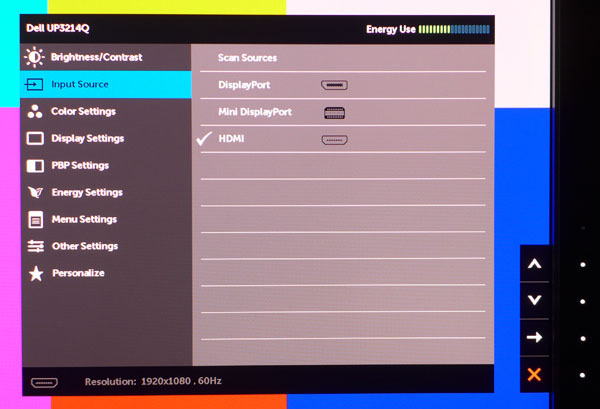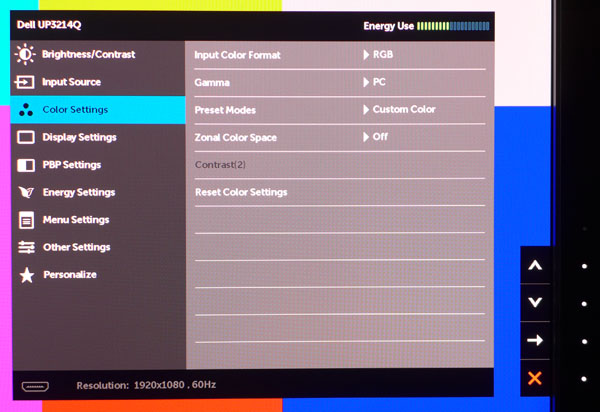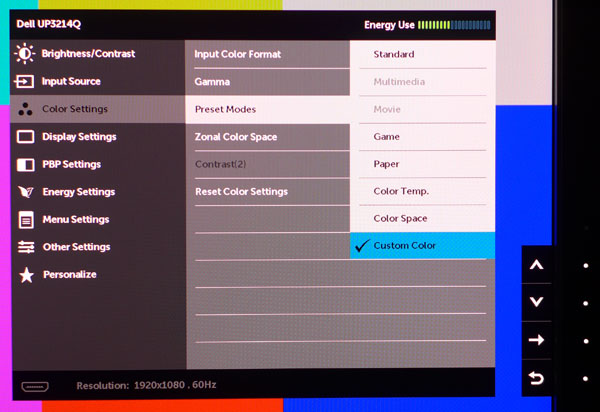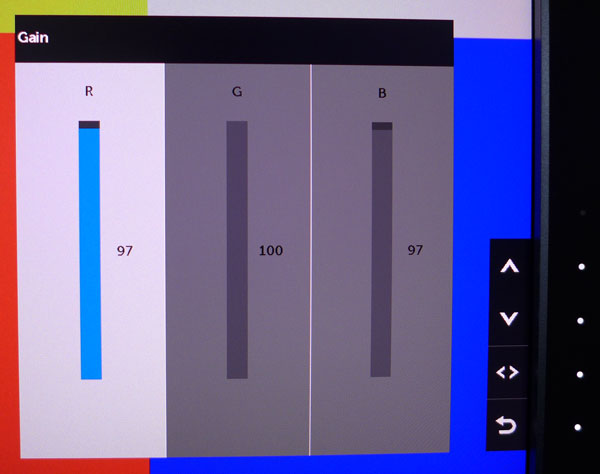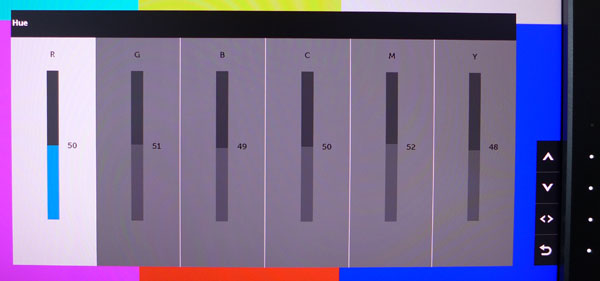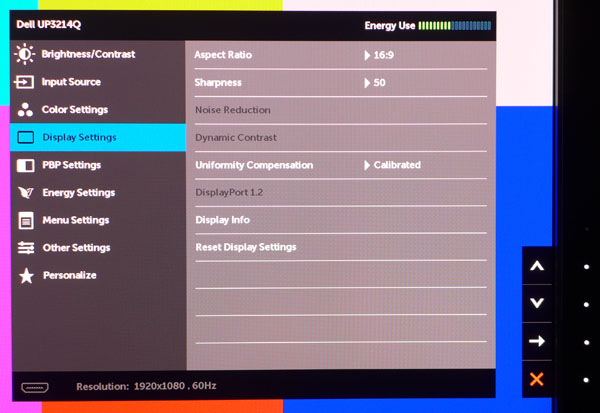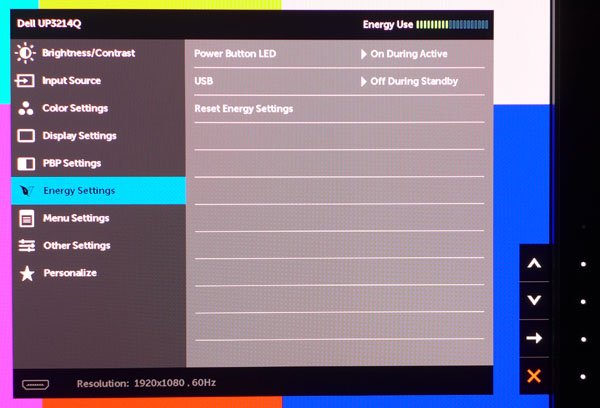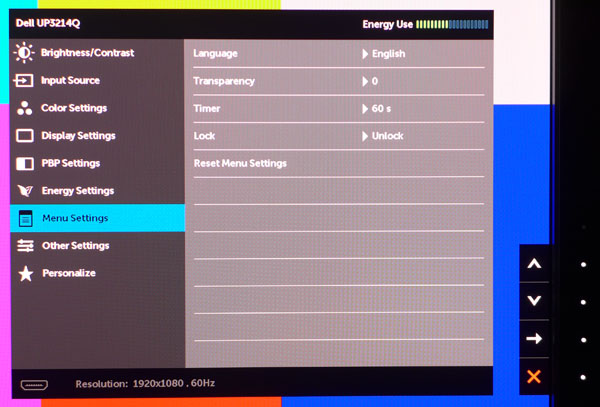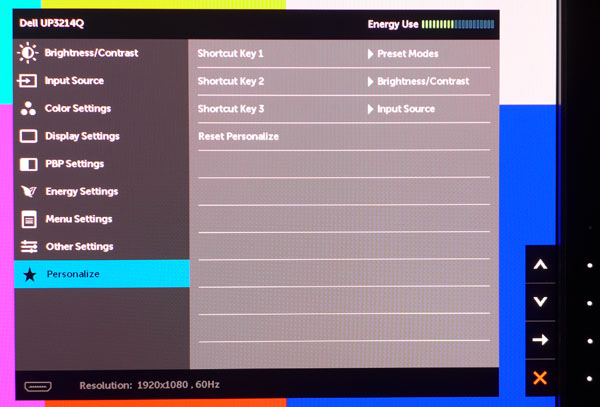Dell UltraSharp 32 Ultra HD Monitor Review: UP3214Q At $3500
OSD Setup And Calibration Of The Dell UP3214Q
Initial Setup
Like Asus' PQ321Q, you need to use a DisplayPort connection to access the monitor’s full native resolution at 60 Hz. And your graphics card must be version 1.2-compatible to support the multi-stream (MST) feature. By default, Dell's UP3214Q comes set with DisplayPort 1.2 disabled. This means that when you first hook it up, the refresh rate will only be 30 Hz. Obviously that's far from ideal for gaming. But you won't want to use your desktop at 30 Hz either. The judder is acutely perceptible in Windows, and jarring if you're accustomed to a 60 Hz screen. Luckily, the fix is as simple as a visit to the OSD. Go to Display Settings and change DisplayPort 1.2 to Enable. If you’re wondering about the dual-HDMI option we saw on the Asus, Dell does not have this. There is only one HDMI port and it’s limited to the 1.4a specification.
We got a nice surprise when we connected the UP3214Q to an AMD Radeon HD 7770. Even though MSI lists the Cape Verde-based card's maximum resolution as 2560x1600, we managed to get its DisplayPort interface to output the full 3840x2160 at 60 Hz. And a driver update from November (13.250.18.0) worked without issue. Since this review focuses on usability and image quality, we didn’t perform any gaming benchmarks. If you plan to engage in high-resolution gaming, a Radeon HD 7700-series card clearly won't cut it.
OSD Tour
The UP3214Q has a large OSD with many options for color calibration, as well as convenience features. It’s controlled by five touch-sensitive buttons on the lower-right side of the bezel. Touching any of them brings up the menu along with icons telling you the function of each button.
Touching the bottom button brings up a quick menu of the most often-used functions. The preset modes number eight, and we’ll describe them in more detail below.
Pressing Menu takes you to the full OSD.
Like most monitors, Contrast has a small range where it’s most effective and won’t crush the brightest detail. The default setting is 50 and you can turn it up to 60 before any clipping occurs. We found 50 to offer the best grayscale accuracy and intra-image contrast.
The Brightness slider controls the backlight rather than the black level, and it has a very wide range. At zero, you’ll see around 33 cd/m2 maximum output, and at 100 you’ll have over 326 cd/m2.
Get Tom's Hardware's best news and in-depth reviews, straight to your inbox.
Here’s where you select your input source. For 3840x2160 pixels at 60 Hz, you need to use DisplayPort. Go down to the Display Settings menu and make sure it’s set to version 1.2, which supports the necessary multi-stream signal.
Now we get to the meat of the OSD.
Aside from Brightness and Contrast, all of the other calibration controls are in the Color Settings Menu. Input Color Format is something we don’t often see. For PC signals, the default setting of RGB is correct. If you connect a source that only outputs YPbPr, like a Blu-ray player, you can choose that option to activate the correct color decoding matrix. Gamma options are only PC or Mac (2.2 or 2.0), and they do measure as indicated. Zonal Color Space is a unique feature where you can have two different color spaces on the screen simultaneously. If you turn this on, you can adjust the Contrast on the left half separately.
There are eight picture modes.
The UP3214Q comes set to Standard, which employs the Adobe RGB 1998 gamut with a D65 white point. This is fairly accurate. However, the better preset is Color Space mode. There you can choose between sRGB or Adobe RGB. Both are extremely close, as you’ll see in our tests. Game and Paper are more interpretive of correct color rather than literal. They should be used only as matter of personal preference. Color Temp. also uses the Adobe RBG gamut and unlocks a single slider that sets the white point by Kelvin value. The two grayed-out modes, Multimedia and Movie, require a YPbPr signal through the HDMI input to activate.
Custom Color opens up high- and low-range RGB adjustments and Hue/Saturation controls for all six colors.
Dell uses the term Gain for the high range and Offset for the low. We calibrated at 80 percent brightness to set the Gains and 30 percent to dial in the Offsets. Defaults for Gain start at maximum, so you’ll have to subtract the different colors to arrive at the desired result. Fortunately, the control resolution is very fine so great precision is possible.
These are the sliders for Hue and Saturation.
The CMS works well, but there is no luminance control, which limits it somewhat. We were able to improve upon the default Adobe RGB 1998 color gamut. However, when we tried creating a custom sRGB setting, we didn’t do as well. Fortunately, the preset one is very accurate, so it’s not an issue. All of the sliders default to the center of their range; again, great precision is easy to achieve.
Now we move on to other features.
Aspect ratio choices are the usual 4:3, Auto, and 16:9. Dell also adds 1:1 to the mix. In this mode, the scaler is bypassed and all signals are pixel-mapped, which means resolutions below the native 3840x2160 are displayed in a window rather than filling the screen.
Sharpness defaults to 50 and should be left at that setting. Any lower and visible softness occurs. Higher settings trigger edge enhancement. Uniformity Compensation works by using an internal look-up table. We ran tests with it off and on and found a few compromises. In short, turning it on improves screen uniformity, while reducing contrast. We preferred to leave it off.
DisplayPort 1.2 is grayed out because we’re using an HDMI input to shoot these photos. Ordinarily, you would have to visit this option to turn on the multi-stream capability required for full-resolution 60 Hz input signals. Be sure you do this. Otherwise, on-screen motion will be choppier at 30 Hz.
This is the signal info window. Not only does it report input resolution and refresh rate, but it also shows the PIP status and your DisplayPort capability; very handy!
In every screen we've shown so far, there is an Energy Use indicator at the top-right. This goes up and down with the backlight setting, though changing the power button LED and USB port options can reduce energy use a bit too.
We’re glad to see a timeout option for the OSD. The maximum is 60 seconds, and that's more than enough for our tweaking purposes. You can’t move the menu around the screen, but because it's always in the lower-right quadrant, that’s not a problem. This is the place to lock out the OSD if you desire.
We found the button sound option intriguing. It turns on a little chime that rings every time you press a button.
Even though there is an Auto-Rotate option, the included stand doesn’t have rotation. You’ll have to use your own mount to take advantage of this.
As always DDC/CI should be left on to allow two-way communications between the display and your computer.
LCD Conditioning runs a series of screen wipes to combat image retention.
The final menu allows you to change the function of the first three touch keys. This gives you one-button access to various options without navigating the full OSD.
Dell UP3214Q Calibration
With so many calibration options available on the UP3214Q, we explored several different scenarios to get the most out of this monitor. If you’re looking for ultimate accuracy (as we do), the Custom Color and Color Space modes are where you’ll spend your time. Color Space mode isn’t adjustable except for Brightness and Contrast, but it’s very accurate. In fact, that's where you get the best sRGB mode. The Adobe RGB option is very good too. Though, for that gamut, you can do even better in the Custom Color mode, where it's possible to adjust grayscale, gamma, and color to a very high degree of accuracy. The only thing missing in the CMS is a luminance slider, but if your goal is Adobe RGB, that isn’t a problem. Check out our final settings.
| Dell UP3214Q Calibration Settings | |
|---|---|
| Picture Mode | Custom Color |
| Brightness | 32 |
| Contrast | 50 |
| RGB Gain | Red 97, Green 100, Blue 97 |
| RGB Offset | Red 50, Green 50, Blue 50 |
| CMS Hue | Red 50, Green 51, Blue 49, Cyan 50, Magenta 52, Yellow 48 |
| CMS Saturation | Red 50, Green 51, Blue 53, Cyan 50, Magenta 48, Yellow 49 |
| Gamma | PC |
| Sharpness | 50 |
If you want to use the sRGB gamut, we suggest the Color Space mode, set to sRGB, with Brightness at 42 and Contrast at 50. Use the appropriate gamma preset for your PC or Mac. The UP3214Q is well worth the effort of calibration as you’ll see in our test results. It turns out to be one of the most accurate monitors we’ve ever measured.
Current page: OSD Setup And Calibration Of The Dell UP3214Q
Prev Page Packaging, Physical Layout, And Accessories Next Page Measurement And Calibration Methodology: How We Test
Christian Eberle is a Contributing Editor for Tom's Hardware US. He's a veteran reviewer of A/V equipment, specializing in monitors. Christian began his obsession with tech when he built his first PC in 1991, a 286 running DOS 3.0 at a blazing 12MHz. In 2006, he undertook training from the Imaging Science Foundation in video calibration and testing and thus started a passion for precise imaging that persists to this day. He is also a professional musician with a degree from the New England Conservatory as a classical bassoonist which he used to good effect as a performer with the West Point Army Band from 1987 to 2013. He enjoys watching movies and listening to high-end audio in his custom-built home theater and can be seen riding trails near his home on a race-ready ICE VTX recumbent trike. Christian enjoys the endless summer in Florida where he lives with his wife and Chihuahua and plays with orchestras around the state.
-
ubercake What I always find entertaining is how these monitor manufacturers will only back their $500+ (in this case $2000+) products for a maximum of 3 years, but my $250 power supply has a 7-year warranty and my $200 SSD has a 5-year warranty.Reply -
s3anister Reply
Yes, but you miss the point.12831333 said:It's so expensive that I could buy more than twenty 1080p monitors.
This is a reasonable expectation, with economies of scale the average consumer will eventually be able to buy a 4K display for $300-$500 USD.12831370 said:I wish in 3 years the price of 4k monitors would come to $300.
Agreed. I've owned a few Dell Ultrasharp monitors and have always been surprised at the short length of warranty compared to what I get from other premium components. Sadly the entire display industry is like this in terms of warranty coverage.12831456 said:What I always find entertaining is how these monitor manufacturers will only back their $500+ (in this case $2000+) products for a maximum of 3 years, but my $250 power supply has a 7-year warranty and my $200 SSD has a 5-year warranty.
You also miss the point. I assume you didn't even read the article.12831763 said:Unacceptible input lag, display not suitable for gaming.
Anyway, great article. I was hoping TH would get around do doing a proper review of this monitor as I'm expecting it to be the benchmark for future 4K panels. -
tttttc "The company also introduced a budget-oriented 28-inch model as well, the P2815Q. Gamers might favor it more, since it's a $700 screen with a faster-responding TN panel."P2815Q has only a refresh rate of 30Hz... gamers might not favor it more...Reply -
ceberle Reply12833028 said:"The company also introduced a budget-oriented 28-inch model as well, the P2815Q. Gamers might favor it more, since it's a $700 screen with a faster-responding TN panel."P2815Q has only a refresh rate of 30Hz... gamers might not favor it more...
We hope to test the P2815Q very soon. In the meantime, we have the UP2414Q in the lab now. This is a 24-inch IPS screen for around $1200.
-Christian- -
Tanquen Why is the bezel so F-ing big? When are desktop monitors (that weight less than a TV and people actually put two or more next to each other) going to have slim or nonexistent bezels?Reply
$3500 16:9?????? Good grief! -
burmese_dude "There’s no question that 4K is here."Good. Cuz I was questioning before I read that. Now I won't question anymore.Reply


